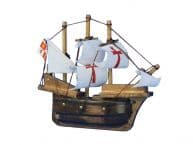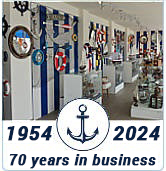Handcrafted Model Ships customers also shopped

|
|

|
Wooden Mayflower Tall Model Ship 20"
Construction
On the afternoon of Monday, 22nd November 1869, a beautiful little clipper ship of 963 tons gross was launched at Dumbarton on the River Leven. On that day, she was given a name that was to become renowned throughout the seafaring world.
Cutty Sark was built for John 'Jock' Willis, a seasoned sailing ship master who had taken over his father’s firm of ship owners in the port of London. Here he became better known as "White Hat Willis" because he always wore a white top hat. His ambition was for Cutty Sark to be the fastest ship in the annual race to bring home the first of the new season's tea from China.
The site of Scott & Linton's yard today
The ship was designed by Hercules Linton, a partner in the Dumbarton firm of Scott & Linton. It is believed that he moulded the bowlines of Willis's earlier vessel, The Tweed into the midship attributes of Firth of Forth fishing boats, creating a beautiful new hull shape that was stronger, could take more sail, and be driven harder than any other.
The company had never built a ship of this size before and ran into financial difficulties, eventually going bankrupt before the ship was completed. The final details of the fitting out had to be completed by William Denny & Brothers, Scott & Linton’s landlords and the guarantors for the completion of the work on the original contract.
The ship was towed to Greenock for final work on her masts and rigging. She was then brought to London to load her first cargo for China.
The Cutty Sark is 280ft (85.4m) long overall and her beam measures 35ft (11m). Her moulded depth is 22.5ft (6.7m) and she weighs 963 tons (978.5 tonnes) gross. The height of the main mast from the main deck to the top is 152ft.
1870-1878: The China Tea Years
On 16th February 1870, the Cutty Sark left London bound for Shanghai, via the Cape of Good Hope, on her first voyage. Commanded by Captain George Moodie, she carried "large amounts of wine, spirits and beer” (Captain’s abstract log). The arrival of the ship at Shanghai, with “manufactured goods”, is listed in The North China Herald of 2nd June 1870. Departing with around 1,450 tons of tea on 25th June, she arrived back in London on 13th October 1870.
This is the first of 8 voyages the ship successfully made to China in pursuit of tea. However, the Cutty Sark never became the fastest ship on the tea trade. Dogged by bad winds and misfortune, she never lived up to the high expectations of her owner during these years. The closest the ship came to winning the tea race was in 1872, when she had the opportunity to race the Thermopylae head-to-head for the first time.
After arriving at Shanghai in late May 1872, she met the Thermopylae when loading her tea cargo. With both sailing from Woosung on 17th June 1872, the two ships closely matched each other through the China Sea and into the Indian Ocean. By 7th August, and with a good tail wind, the Cutty Sark found herself a good 400 miles ahead of the Thermopylae. On 15th August, disaster struck when the Cutty Sark’s rudder gives way. After reconstructing the rudder twice in heavy seas, the ship arrived back at London on 19th October, around 7 days after her rival. The courage and determination of Captain Moodie and his crew won the Cutty Sark great credit, but Moodie retired from his command of the ship due to stress and the ship was never to get this close to winning the tea race again.
1878-1883: Tramping for cargoes
Cutty Sark successfully collected her last Chinese tea cargo in 1877. In December of that year, the ship departed London bound for Sydney for a coal cargo, and then went onto Shanghai. Arriving at China in April 1878, the ship’s master, Captain Tiptaft, could not consign a tea cargo. By this time, steam ships had taken over this trade.
Steam ships had arrived onto this market with the opening of the Suez Canal in 1869. The Canal gave the steam ships a quick and direct route from the Mediterranean into the Red Sea, whilst the sailing ships were unable to access the Canal because of their reliance on the trade winds that gusted around the coast of Africa.
Unable to find a tea cargo, Captain Tiptaft died at Shanghai in October 1878. His First Mate, James Wallace, was promoted to the command of the Cutty Sark.
With tea no longer available, the ship started to take different cargoes of various qualities around the world. For example, she took coal from Nagasaki in Japan to Shanghai; jute from Manila to New York; and jute, castor oil, tea and the Australian mail from Calcutta to Melbourne in March 1881.
In 1880, the ship’s First Mate, Sidney Smith, by all accounts a bully and disliked by the crew, killed (with considerable provocation) seaman John Francis. Smith was confined to quarters, but at Anjer Captain Wallace connived at his escape. The crew, incensed, downed tools and refused to work resulting in most of the sailing being done by the six apprentices and four tradesmen. On 5th September the ship was becalmed in the Java Sea for three days. With the guilt, calm, steaming heat and realisation that his career was finished, Wallace jumped overboard. Although a rescue attempt was mounted, the only sign of Wallace was the number of sharks swimming furiously about…
To make matters worse, on arrival at Anjer, William Bruce was transferred from the Halloween and appointed Master of the Cutty Sark. By all accounts, Bruce was an incompetent, drunken master who connived with the Mate to remove the expensive Australian crew members, pocketing their wages. He was also negligent, failing to pick up enough provisions, resulting in the crew becoming half starved. On arrival at New York in April 1882, it appears that an inquiry was held into the conduct of the Master and the First Mate, resulting in them being suspended from service and the crew were given a discharge.
As a result, Captain F. Moore and his Mate were transferred from the Blackadder to the Cutty Sark and it was under his command that the ship embarked upon her most successful period of working life.
1883-1895: The Australian Wool Years
In July 1883, the Cutty Sark left Gravesend bound for Newcastle N.S.W, arriving in October. After loading 4289 bales of wool and 12 casks of tallow, she departed in December 1883 and arrived back in London in March 1884. Her return passage of 83 days was the best of the year, beating every ship sailing at about the same time by 25 days to over a month. This was a remarkable feat, considering that the Cutty Sark was now 14 years old, almost halfway through her expected working life of 30 years.
Captain Moore left the ship in 1885, and was replaced by the most successful Master who ever commanded the Cutty Sark; Richard Woodget. Captain Woodget’s skill lay as a successful man-manager and fearless navigator, getting the best out of both the ship and his crew. In order to catch the Roaring Forties trade winds, encountering some of the most violent gales and seas on Earth, Woodget would travel further south than any previous commander. This was perilous, as the ship came into frequent contact with icebergs around Cape Horn (the southern tip of South America). Woodget was also a keen photographer and he has left many striking images of the ship passing icebergs as well as shots of her in Sydney harbour.
Fortunately, the ship survived and produced stunning passage times. On his first voyage in command, the ship sailed from England to Sydney in 77 days, and returned to the UK from Australia in 73 days. This was the start of 10 years domination by the Cutty Sark in the wool trade. The ship soon established herself as the fastest vessel, the ‘last chance’ ship to make the English January wool sales.
In July 1889, the Cutty Sark was involved in a famous incident with the crack P&O steam ship Britannia. On the night of the 25th July, Britannia, doing between 14.5 and 16 knots, was overhauled by the Cutty Sark doing a good 17 knots. Robert Olivey, Second Officer on Britannia, watched the lights of the sailing ship overhauling his vessel with amazement and called Captain Hector. Neither could have known it was Cutty Sark, and Britannia’s log read with great amazement, “Sailing ship overhauled and passed us!”
In January 2006, letters written by Clarence Ray (apprentice on board the Cutty Sark in 1894) were brought to light by Dick Ray, his great-nephew. This important archive reveals how a fifteen year old boy lived and worked alongside his shipmates. In particular, he writes to his mother about the food on board the ship (including the delights of "Salt Tram Horse", "Leu Pie" and "Junk and Spuds"), dodging Captain Woodget's vicious collie-dogs, how the ship was swamped by the sea in bad weather and his duties, which included rowing the Master ashore for picnics, while the ship was in harbour.
As steam-ships moved further into the wool trade in the 1890s, the Cutty Sark began to make less money for her owner. After the ship returned to the UK from Brisbane in 1895, Jock Willis sold her to a Portuguese firm, J. Ferreira & Co. for £2,100. Woodget transferred to the Coldinghame, and the Cutty Sark left British ownership.
1895-1922: The Portuguese Years
The Ferreira at Birkenhead, about 1910
After being sold to J. Ferreira & Co. Cutty Sark was renamed the Ferreira. Reminiscent of her days in the late 1870s and early 1880s, Ferreira tramped various cargoes mainly between Portugal and her empire, and was a regular visitor to Rio, New Orleans, Mozambique, Angola and the UK. In the twentieth century she traded regularly between Oporto, Rio, New Orleans and Lisbon, and her crew claimed she was still capable of doing sixteen knots.
In October 1915 Portugal declared war on Germany which meant that the ship was in constant danger of being sunk by enemy naval activity. She survived unscathed until May 1916, when the rolling of the ship in bad weather led to the dismasting of the main mast and everything above the fore lowermast and the mizzen top-masts. Badly damaged, Ferreira was towed into port, arriving at Table Bay, South Africa. The cost and rarity of adequate masts and yards due to the war meant that she was converted into a barquentine (fore and aft rig) over an eighteen month period at Cape Town.
By January 1922 Ferreira ran into a Channel gale, and the captain put into Falmouth harbour to repair the damage. Wilfred Dowman, a retired windjammer skipper and owner of the training ship Lady of Avenel, saw the ship and set out to buy her. However, she returned to Lisbon without further mishap and was sold to a new Portuguese owner who changed her name to Maria do Amparo. But Dowman still wanted the ship, and at a price of £3,750 (more than what she was worth even in 1895) it was brought back to Falmouth.
In 1923 her old name and nationality was restored; the Cutty Sark had returned to British ownership.
1922-1938: The Falmouth Years
A restored Cutty Sark in Falmouth harbour, around 1924
After saving the Cutty Sark for the nation, Wilfred Dowman restored the ship to a close approximation of her appearance as a tea and wool clipper. This was a considerable feat, due to the shortage of necessary materials caused by the First World War. She was also the first historic vessel since Drake’s Golden Hind in the sixteenth century to be opened to the public, and oral history interviews have revealed how boatmen used to take many visitors out to the ship.
The Cutty Sark was used as a cadet training ship, where half a dozen boys from different backgrounds would live on board and train for a career in either the Royal Navy or the Merchant Marine.
However, Captain Dowman died in 1936, and his widow decided that she was unable to maintain the ship at her own cost. Therefore, the Cutty Sark was sold to the Incorporated Thames Nautical Training College, Greenhithe, and left Falmouth in 1938 accompanied by cheers from well-wishers and hoots from vessels in the harbour. This was the last time that she went to sea.
1938-1954: The Greenhithe Years
Cutty Sark alongside HMS Worcester, Greenhithe, around 1938
In 1938, the Cutty Sark arrived in Greenhithe, Kent, as an auxiliary vessel for the cadet training ship HMS Worcester. The ship continued her role in training officers for service in the Royal and Merchant Navies, which was soon to be vital with the outbreak of the Second World War in 1939.
In her early days at Kent, the ship was regularly used for sail-training drill and was lovingly maintained by cadets who were inspired by the ship’s record-breaking history. However, by the early 1950s, the College acquired a newer training vessel and were unwilling to keep the Cutty Sark. A new home had to be found.
In 1951, the ship was sent to London, to be moored in the Thames as part of the Festival of Britain celebrations. Returning to Greenhithe, it was not long before her plight became noticed by those determined to save her from the scrap-yard.
The Cutty Sark Society was formed by Frank Carr, Director of the National Maritime Museum, and patronised by HRH The Duke of Edinburgh. In a special ceremony, just before the coronation of Queen Elizabeth II, Prince Philip took possession of Cutty Sark on behalf of the the society.
1954 - date: The Greenwich Years
In December 1954, in an event of such significance it was captured by BBC cameras, the Cutty Sark was towed into a specially constructed dry dock at Greenwich. Three years of painstaking restoration work followed, taking the ship back to her tea clipper appearance. She has remained in Greenwich, in her dry-dock, to this day.
Since her official opening in 1957 by HM The Queen (broadcast live on the BBC), Cutty Sark has been visited by over 15 million people from all over the world. Now, over 135 years after her launch (long since outliving her life expectancy of just 30 years), she is in urgent need of conservation. Keep checking the website for updates on the Cutty Sark Conservation Project, and from Spring 2007, a temporary visitor facility will be open, explaining why we are conserving the ship and the process of conservation.





 Handcrafted Cast Iron
Handcrafted Cast Iron



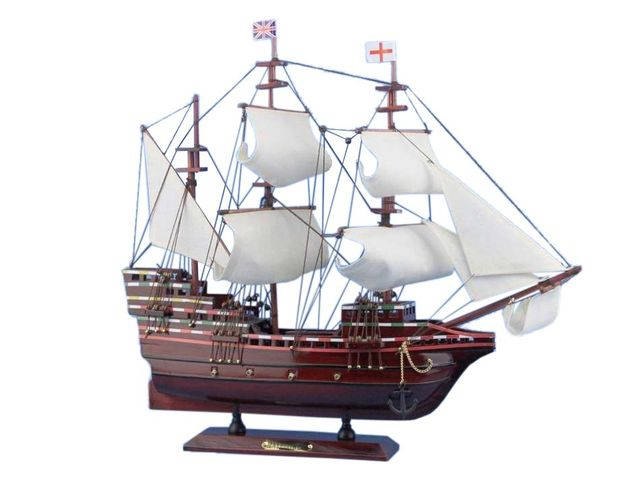






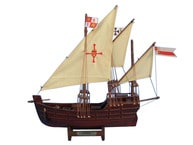
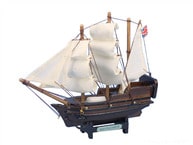


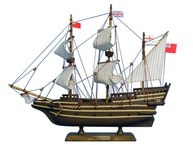
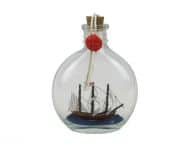

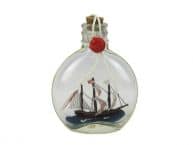
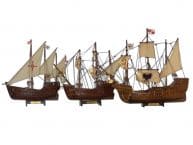
.jpg)
